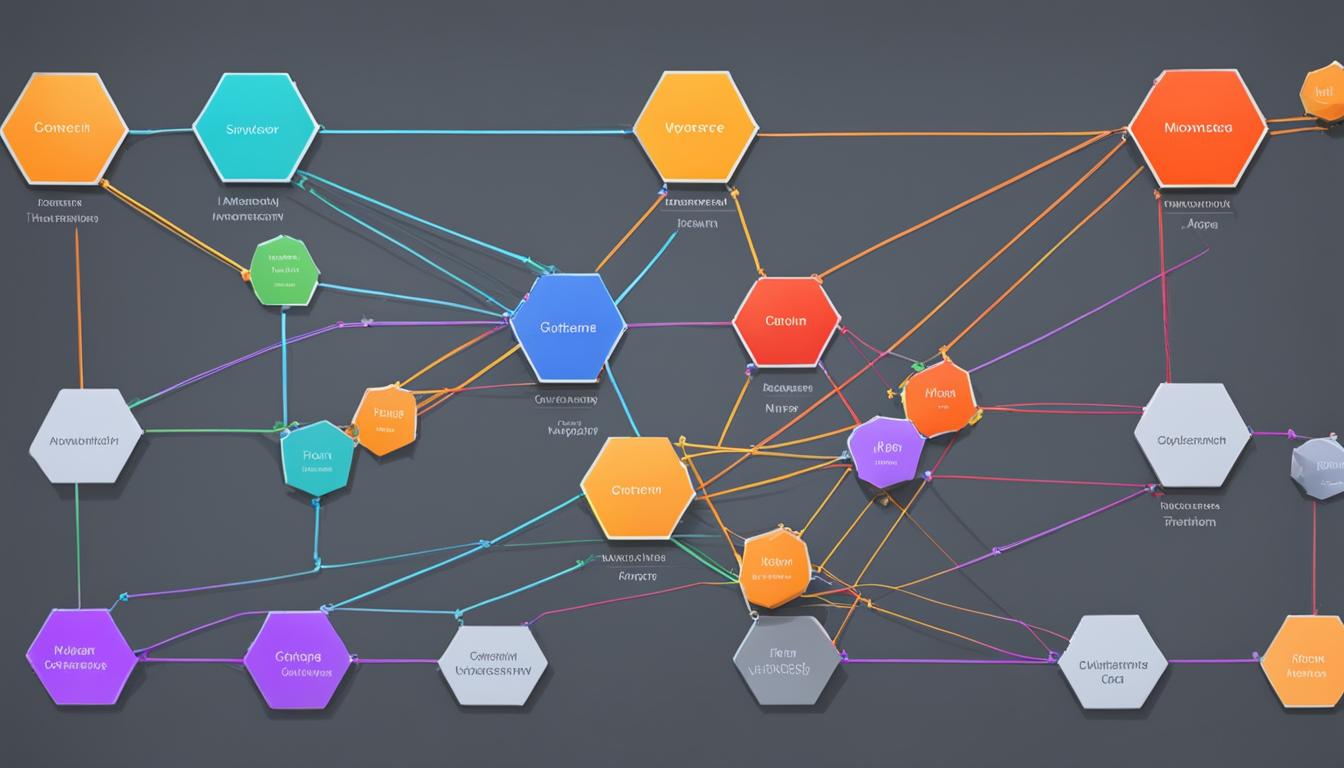Existing customer? Sign in
Understanding Software Design: A Primer

Did you know that software is responsible for powering the majority of today’s technological advancements? From smartphones and computers to cars and cameras, software is everywhere, making our modern lives possible. But have you ever wondered how all these complex systems are designed and developed?
In this article, we will delve into the world of software design, exploring its importance and implications for businesses and strategic decision-making. Whether you’re a programming enthusiast or a manager looking to understand the value of software development, this primer will provide you with valuable insights to navigate the ever-evolving digital landscape.
Key Takeaways:
- Software design is crucial for creating efficient and reliable systems.
- Understanding software design principles empowers managers to make informed decisions about technology solutions.
- Agile methodology is a popular approach to software development that promotes flexibility and collaboration.
- User experience (UX) is a critical aspect of software design, focusing on creating intuitive and engaging interfaces.
- Testing is essential to ensure code quality and improve software reliability.
The Importance of Software
Software plays a crucial role in driving code quality and user experience. Well-designed software can enhance the performance, reliability, and security of systems. It is a key aspect of software engineering, ensuring that applications meet the needs and expectations of users. By understanding software design principles, managers can make better decisions regarding the strategic value of IT and the potential for technology-driven savings.
Software design is not just about creating functional applications; it also encompasses the quality and usability of the code. High-quality code is essential for ensuring that software operates efficiently, minimizes errors, and is easy to maintain and scale. On the other hand, poor code quality can lead to bugs, system failures, and negative user experiences.
The user experience (UX) is a critical consideration in software design. A well-designed user interface, intuitive navigation, and responsive interactions are essential for creating positive user experiences. By prioritizing the user experience, businesses can increase customer satisfaction, improve user retention, and gain a competitive edge in the market.
Software engineering involves applying structured processes and methodologies to develop high-quality software. It encompasses various phases, including requirements gathering, design, development, testing, and maintenance. Each stage requires careful attention to detail and adherence to best practices to ensure that the final product meets the specified requirements and quality benchmarks.
Software engineering also involves considering the scalability, reliability, and security of the software. Scalability refers to the ability of the software to handle increasing levels of workload and users without sacrificing performance. Reliability ensures that the software operates consistently and predictably under various conditions. Security involves protecting the software and its data from unauthorized access, breaches, and vulnerabilities.
“Well-designed software can have a significant impact on the success of a business. It can drive operational efficiency, cost savings, and customer satisfaction. Investing in code quality and user experience is an investment in the long-term success and sustainability of the software.”
The Impact of Code Quality
| Benefits of High Code Quality | Consequences of Poor Code Quality |
|---|---|
| Improved software performance | Slower execution and system crashes |
| Enhanced system reliability | Increased number of bugs and errors |
| Reduced maintenance efforts and costs | Difficulties in code maintenance and updates |
| Better scalability and flexibility | Challenges in scaling and adapting to changing requirements |
| Enhanced security and data protection | Increased vulnerability to cyberattacks and breaches |
Table: Impact of Code Quality on Software
Investing in code quality is crucial for software engineering success. It involves adhering to coding standards, conducting code reviews, performing thorough testing, and utilizing automated code analysis tools. By prioritizing code quality, developers and businesses can avoid potential pitfalls, improve software performance, and deliver better user experiences.
Principles of Software Design
Software design is guided by certain principles that are essential for creating effective and efficient solutions. These design principles contribute to the overall system architecture and play a crucial role in developing robust and scalable software systems. In this section, we will explore some of the key design principles that shape the software design process.
1. Modularity
Modularity is a fundamental principle of software design that involves breaking down the software into smaller, manageable components. By dividing the system into modular units, each responsible for a specific task or functionality, developers can enhance code reusability, maintainability, and scalability. It allows for easier debugging, testing, and updates, making the overall system more flexible and adaptable to changes.
2. Abstraction
Abstraction focuses on hiding unnecessary details and providing a simplified representation of the software’s functionality. By abstracting complex implementation details, developers can create a high-level view of the system, making it easier to understand and communicate. This principle improves code readability, maintainability, and scalability by reducing dependencies and promoting a modular design approach.
3. Encapsulation
Encapsulation is a design principle that encapsulates data and behavior within objects. It ensures that the internal state of an object is protected and can only be accessed through well-defined interfaces. Encapsulation facilitates code organization, improves code reusability, and enhances the security and integrity of the system. By encapsulating related data and operations within objects, developers can create self-contained units that can be easily managed and maintained.
4. Separation of Concerns
The principle of separation of concerns involves separating different aspects of the software into distinct modules or components. Each component focuses on a specific concern, such as user interface, data storage, or business logic. By separating concerns, developers can improve code organization, enhance code reusability, and simplify system maintenance. This principle promotes a modular design approach, allowing for better collaboration among development teams and facilitating future updates and scalability.
| Design Principle | Description |
|---|---|
| Modularity | Breaking down the software into smaller, manageable components. |
| Abstraction | Hiding unnecessary details and providing a simplified representation. |
| Encapsulation | Encapsulating data and behavior within objects. |
| Separation of Concerns | Separating different aspects of the software. |
Methodologies for Software Design
When it comes to software development, choosing the right methodology is crucial for success. One popular approach in the industry is the agile methodology, which focuses on flexibility, collaboration, and iterative development. This methodology recognizes that software requirements can change over time and encourages frequent feedback and adaptation to deliver high-quality solutions.
The agile methodology follows a set of principles that prioritize individuals and interactions, working software, customer collaboration, and responding to change. It promotes a cross-functional team dynamic, where developers, designers, testers, and stakeholders work closely together throughout the development process.
By dividing the project into smaller, manageable increments called sprints, agile methodology enables teams to deliver tangible results more frequently. This iterative approach allows for continuous improvement and encourages teams to learn from their experiences, making adjustments along the way.
Other methodologies commonly used in software development include the waterfall, iterative, and spiral methodologies. Each approach has its own strengths and weaknesses, making it suitable for different types of projects and team dynamics.
The waterfall methodology follows a sequential process, where each phase must be completed before moving on to the next. This approach can be beneficial for projects with well-defined requirements and limited changes expected during development. However, it may lack flexibility in accommodating changes or updates once the development process starts.
The iterative methodology, on the other hand, focuses on developing solutions through repeated cycles. It allows for incremental changes and enhancements based on feedback received during each iteration. This methodology is useful when requirements might evolve during development or when there is a need to improve upon an existing solution.
The spiral methodology combines elements of both the waterfall and iterative approaches. It follows a cyclical process, with each iteration incorporating feedback and incorporating changes from the previous cycle. This methodology is often used for large-scale projects that require continual risk analysis and mitigation.
Choosing the right methodology for software development depends on various factors, such as project requirements, timeline, and team dynamics. It is essential to assess these factors and select the methodology that aligns best with the goals and objectives of the project.
Enhancing User Experience through Software Design
User experience (UX) is a critical aspect of software design as it focuses on creating interfaces that are intuitive, easy to use, and engaging for users. By incorporating user-centered design practices, businesses can ensure that their software meets the needs and expectations of their target audience.
One of the key aspects of UX design is understanding user needs. This involves conducting user research to gain insights into their preferences, behaviors, and pain points. By gathering this information, software developers can make informed decisions about the design and functionality of their applications.
Another important element of UX design is the incorporation of design principles that enhance usability and satisfaction. These principles include simplicity, consistency, and feedback. Simplicity ensures that the software is easy to understand and navigate, while consistency creates familiarity and reduces cognitive load. Feedback mechanisms, such as error messages or visual cues, provide users with information and guidance to improve their experience.
The goal of UX design is to create software that not only solves problems but also delights and engages users. By prioritizing the user experience, businesses can differentiate themselves in the market and create a positive brand image.
Benefits of Prioritizing User Experience in Software Development
By prioritizing UX in software development, businesses can reap several benefits:
- Increased user satisfaction: Well-designed software that meets user needs and provides a seamless experience can significantly enhance user satisfaction.
- Improved user retention: A positive user experience increases the likelihood of users returning to the software and becoming loyal customers.
- Reduced support and training costs: Intuitive and user-friendly interfaces reduce the need for extensive user support and training, resulting in cost savings.
- Higher conversion rates: Users are more likely to convert into paying customers or take desired actions when they have a positive experience with the software.
- Competitive advantage: By offering a superior user experience, businesses can differentiate themselves from competitors and attract more users.
Overall, prioritizing user experience in software development is essential for businesses looking to create meaningful, impactful, and successful applications.
| User Experience | Software Development |
|---|---|
| Focuses on creating intuitive and engaging interfaces | Drives the development process to meet user needs |
| Employs user-centered design practices | Utilizes various methodologies to deliver high-quality software |
| Enhances usability and satisfaction through design principles | Ensures code quality and reliability through testing and QA processes |
| Increases user satisfaction and retention | Reduces support and training costs |
| Improves conversion rates and competitive advantage | Enables businesses to differentiate themselves in the market |
Software Quality and Testing
Code quality is a critical aspect of software design, ensuring that the software functions as intended and is free from defects or vulnerabilities. Achieving code quality requires rigorous testing throughout the development process.
Software testing plays a crucial role in identifying and fixing bugs, improving software reliability, and enhancing the overall user experience. Different types of testing are conducted to validate the software’s functionality and performance:
- Unit testing: Involves testing individual components, modules, or functions of the software to validate their behavior and correctness.
- Integration testing: Focuses on testing the interactions between different components or modules of the software to ensure seamless integration and interoperability.
- User acceptance testing: Provides insights into how the software performs in real-world scenarios and whether it meets the users’ expectations and requirements.
Testing not only helps identify and resolve issues but also serves as a quality assurance measure to measure code quality and ensure adherence to coding standards. Quality assurance processes and tools are utilized to assess the code’s robustness and maintainability.
“Quality is not an act, it is a habit.” – Aristotle
By prioritizing software testing, organizations can enhance the reliability, performance, and security of their applications. Rigorous testing processes, such as test-driven development and continuous integration, contribute to continuous improvement and deliver high-quality software to end-users.
| Benefits of Software Testing | Importance of Code Quality |
|---|---|
| 1. Identifies and fixes bugs | 1. Ensures software functions as intended |
| 2. Improves software reliability | 2. Enhances user experience |
| 3. Validates functionality and performance | 3. Reduces system vulnerabilities |
| 4. Provides insights into user expectations | 4. Facilitates software maintenance |
Conclusion
Understanding software design is essential for managers and businesses to make informed decisions regarding technology solutions. By recognizing the importance of software and its implications, they can drive code quality, enhance user experience, and optimize system architecture.
By embracing the principles of software design, businesses can stay ahead in the ever-evolving digital landscape. Modularity, abstraction, encapsulation, and separation of concerns contribute to the overall system architecture, ensuring effective and efficient solutions.
Additionally, adopting methodologies such as agile methodology in software development enables flexibility, collaboration, and iterative development. This approach fosters frequent feedback and adaptation, ultimately delivering high-quality software in a timely manner.
Furthermore, prioritizing user experience (UX) in software design allows businesses to create interfaces that are intuitive, easy to use, and engaging. Understanding user needs, conducting user research, and incorporating design elements that enhance usability and satisfaction contribute to a positive brand image.
Overall, understanding software design, embracing its principles and methodologies, and prioritizing code quality, user experience, and system architecture empower businesses to leverage software as a strategic asset in the digital age of technology solutions.
FAQ
What is software design?
Software design is the process of creating a plan or blueprint for developing software applications. It involves defining the structure, behavior, and functionality of the software to meet specific requirements.
Why is software design important?
Software design is important because it ensures code quality and enhances user experience. Well-designed software improves performance, reliability, and security. It also helps businesses make better strategic decisions regarding IT investments and potential cost savings.
What are the principles of software design?
The principles of software design include modularity, abstraction, encapsulation, and separation of concerns. Modularity breaks down the software into smaller components, abstraction simplifies the representation, encapsulation encapsulates data and behavior, and separation of concerns separates different aspects of the software.
What methodologies are used in software design?
Agile methodology is a popular approach that emphasizes flexibility, collaboration, and iterative development. Other methodologies include waterfall, iterative, and spiral, each with its own strengths and weaknesses. The choice of methodology depends on project requirements and team dynamics.
What is user experience (UX) in software design?
User experience focuses on creating interfaces that are intuitive, easy to use, and engaging for users. It involves understanding user needs, conducting user research, and incorporating design elements that enhance usability and satisfaction.
Why is code quality important in software design?
Code quality ensures that the software functions as intended and is free from defects or vulnerabilities. Rigorous testing, including unit testing, integration testing, and user acceptance testing, helps identify and fix bugs, improves software reliability, and enhances the overall user experience.
How can understanding software design benefit businesses?
Understanding software design enables businesses to make informed decisions about technology solutions. It helps drive code quality, enhance user experience, and optimize system architecture, allowing businesses to stay ahead in the digital landscape and leverage software as a strategic asset.
Source Links
- https://2012books.lardbucket.org/pdfs/getting-the-most-out-of-information-systems-v1.2/s13-understanding-software-a-prime.pdf
- https://thenewstack.io/primer-understanding-software-and-system-architecture/
- https://learn.saylor.org/mod/book/tool/print/index.php?id=37840&chapterid=22009




